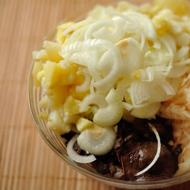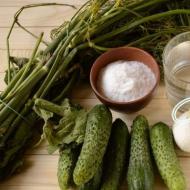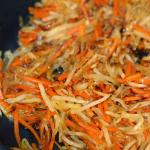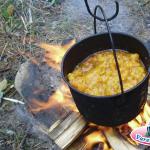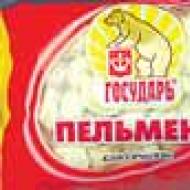
Dumplings to which category belong. Delicious dumplings are expensive
Dumplings, which tested the "Public Control" in November 2010, you can safely feed the family - this was the conclusion of independent experts. Laboratory tests revealed no abnormalities in microbiological and organoleptic characteristics - taste, smell and appearance.During the examination, experts also answered the following questions:
- whether the technical conditions that are developed by the manufacturers themselves are complied with in the manufacture;
- is it always worth being guided when choosing a high price for semi-finished products?
Quality indicators dumplings
According to GOST R 52675-2006 "Semi-finished meat and meat-containing. General technical conditions", which entered into force on 01/01/2009, dumplings must have lettering on the packaging of category A, B, C, D and D.These designations mean the amount of meat (muscle tissue) in products:
- category A dumplings contain 80% or more meat;
- category B dumplings - 60-80%;
- category B dumplings - 40-60%;
- category G dumplings - 20-40%;
- dumplings category D - less than 20%.
The results of the examination of the quality of ravioli
The samples presented were evaluated by an expert commission on such indicators as “mass fraction of protein”, “mass fraction of fat in minced meat”, “mass fraction of minced meat”, composition of minced meat, appearance, smell and taste.Samples of dumplings, relevant regulatory documents
, producer LLC Talosto-Product, St. Petersburg, category G - the most lean dumplings, contain only 10.3% of fat in mince Classic dumplings "Sovereign", producer of CJSC PK Korona, Borovichi, category B - high mass fraction of protein 18.4%
Classic dumplings "Sovereign", producer of CJSC PK Korona, Borovichi, category B - high mass fraction of protein 18.4%
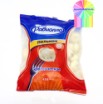 , producer LLC “Ravioli”, St. Petersburg, category G - a large amount of minced meat 48%, high mass fraction of protein 18.3%
, producer LLC “Ravioli”, St. Petersburg, category G - a large amount of minced meat 48%, high mass fraction of protein 18.3%
 Classic dumplings "Caesar", producer LLC "Morozko", St. Petersburg, category B - average mass fraction of minced meat 42.7%, high fat content 28.9%, low protein content 14.7%
Classic dumplings "Caesar", producer LLC "Morozko", St. Petersburg, category B - average mass fraction of minced meat 42.7%, high fat content 28.9%, low protein content 14.7%
Samples of ravioli with deviations from regulatory documents
 Pelmeni “Monastic Traditions”, producer LLC “Traditions IPC”, St. Petersburg, category D - mass fraction of protein is underestimated: 8.9% instead of 10%
Pelmeni “Monastic Traditions”, producer LLC “Traditions IPC”, St. Petersburg, category D - mass fraction of protein is underestimated: 8.9% instead of 10%  Siberian Premium Dumplings, producer of Siberian Delicacy LLC, category G - the highest amount of minced meat is 56.5%, but the low protein content is 10.2%; does not correspond to the mass fraction of fat: 20.9% instead of 18.5%
Siberian Premium Dumplings, producer of Siberian Delicacy LLC, category G - the highest amount of minced meat is 56.5%, but the low protein content is 10.2%; does not correspond to the mass fraction of fat: 20.9% instead of 18.5%
 Pelmeni “Vkusnetskie” classic, producer “Petroholod - food technologies” LLC, St. Petersburg, category G - contain less than whole forcemeat 28%; does not correspond to the mass fraction of fat: 30.3% instead of 15%, is the fattest of all samples
Pelmeni “Vkusnetskie” classic, producer “Petroholod - food technologies” LLC, St. Petersburg, category G - contain less than whole forcemeat 28%; does not correspond to the mass fraction of fat: 30.3% instead of 15%, is the fattest of all samples
Not provided Technical conditions
 , producer of LLC Food Factory “Russky Product”, St. Petersburg, category G - low amount of protein 8.9%, high content of minced meat 48.3%
, producer of LLC Food Factory “Russky Product”, St. Petersburg, category G - low amount of protein 8.9%, high content of minced meat 48.3%
These examinations relate exclusively to specific samples submitted for examination, and not all similar products of these manufacturers.
Expert conclusions about the quality of ravioli
All samples of dumplings are not adhered, undeformed, the edges are well sealed, the stuffing does not protrude, the surface is dry.Cooked dumplings have a taste and aroma characteristic of this type of product. The stuffing is moderately juicy, with the aroma of spices, without foreign taste and smell.
The composition of the minced meat of all samples corresponds to the composition stated on the label.
Low protein levels indicate the use of cheap meat. Also, the reason may be the addition of minced soy or crackers, which is not a violation if the consumer is informed about the additives on the product label.
Some manufacturers compensate for low protein levels with high fat content by adding speck to mincemeat. The mass fraction of fat should correspond specified in regulatory documents.
According to experts, the high price does not always indicate the highest quality products. So, Caesar dumplings from Morozko LLC have the highest cost among the samples, but the mass fraction of protein in them is low - only 14.7%, and the mass fraction of fat, by contrast, is 28.9%. Also, this sample is not a record for the number of minced meat, it has an average value of 42.7%.
According to the materials of the St. Petersburg public consumer organization
According to GOST, dumplings are divided into five categories. The filling of the category “A” product must contain more than 80% meat, “B” - from 60 to 80%, “C” - from 40 to 60%, “G” - from 20 to 40%, “D” - less than 20 % The rest is soy, flavorings and even semolina.
Dumplings category A they are presented on the market very modestly, but at quite immodest prices: the average bill per kilogram is 250 rubles. Category “B” dumplings cost on average 200-220 rubles per kilo, which is also expensive for most consumers. And since it is necessary to feed everyone, regardless of the purse content, the manufacturers mainly develop an economy-class product segment, which includes meat-containing semi-finished products of the “C, D, D” categories (average bill is 100 rubles per kilogram of semi-finished products).
An independent examination of dumplings of several brands was carried out.
Most manufacturers found it difficult not to meet their own specifications. Take, for example, a sample of Baltiya LLC: the mass fraction of protein in the meat of ravioli according to regulatory documentation (ND) should be no less than 5%, in fact, we have 11%. The mass fraction of fat in the stuffing should not exceed 35%, the actual figure is 4 times lower. Agree, to comply with intentionally inflated / underestimated indicators in this case is quite simple.
Take another manufacturer - Talosto-Food Ltd. (Bogatyrskie dumplings). Here the “gate” is even wider: in TU, protein is not standardized at all. The mass fraction of fat in minced meat by ND should not exceed 18%, in fact - 7.9. In fact, this indicator for TU has a double margin of safety.
In addition to laboratory tests, experts conducted a tasting of dumplings samples. According to the competent jury, the highest score (4.9 points) was deserved by the dumplings of the “Sovereign” trademark - the “Real” dumplings of the category “A”. Considering the cost of the semi-finished product - 233 rubles. 10 kopecks for a 900-gram package, the result is quite expected.
On the "four" were evaluated product samples LLC Ravioli, LLC PK Russky Produkt and LLC Daria. All three "horoshist" belong to the category "G". There were no significant differences in physicochemical parameters.
Tasting assessment of samples of semi-finished products Baltia LLC and Morozko LLC amounted to 3 points. Some TM dumplings "7 minutes" were covered with cracks, the dough was heavy and not elastic enough. The consistency of mince is slightly rubbery. Experts noted that the taste of offal and poultry meat prevailed in the dumplings.
Do dumplings “Favorite classic traditions” the smell of onions and fowl prevailed, the mince was not mixed enough, and the dough was heavy and harsh in the places of seeding. In the sample of bogatyr ravioli with beef, the taste of by-products prevailed. Also, experts have indicated that the dough is heavy, not sufficiently elastic, the color is grayish, and the surface is powdery when finished. Stuffing was loose with the presence of small cartilage tissue. The final mark is 2.8 points.
At the end of the list is a sample of dumplings "Russian" classic production LLC "Petroholod - food technology."Boiled dumplings surprised unpleasant taste and smell. The stuffing was with a taste and smell of oxidized fat. Such “delights of taste” were rated by the tasting commission below all tested samples - by 2 points.
These dumplings had the lowest price - only 63 rubles. 90 kopecks per kilogram of semi-finished product. For comparison: dumplings "Bogatyrsky", which belong to the lower category "D" cost 99 rubles. 90 kopecks for 900 grams.
Dumplings - the product is extremely popular. The market presents an incredible number of different brands of dumplings in a variety of packages. Most of this variety, alas, is the real rubbish. However, if you wish, you can find more or less decent factory dumplings, although they, of course, will be worse than homemade ones.
Looking at the packaging
Everyone knows that on the front side of a pack of dumplings are beautiful names, bright pictures and other zavlelochochki. Useful information there is usually zero (although some manufacturers put on the front side information about the weight of the product). All important information is on the back of the package, sometimes written in rather small letters.
What should be indicated on the pack with dumplings? First of all, the legal name and address of the manufacturer, as well as a bar code. These data must be present necessarily, their absence indicates the "underground" production. In addition to information about the manufacturer and the barcode, the pack should also indicate the composition, type and category of ravioli. And, of course, the release date and expiration date. Clear, non-broken numbers.
Semi-finished products in dough (frozen) with category A meat filling. The share of meat in the filling is at least 80% of its total volume. Allowed no more than 20% of additives (eggs, milk protein, water, onions, etc.). The proportion of muscle tissue (that is, meat itself, without fat and cartilage) is at least 80%. These are the best dumplings, but that's bad luck - I never met them on sale.
Semi-finished products in dough (frozen) with meat stuffing of category B. The share of meat in the filling is at least 60% of its total volume. The proportion of muscle tissue - not less than 60% of the total volume of the filling. No more than 40% of additives are allowed: eggs, milk or soy protein, water, starch, onions ... Such dumplings are quite common for sale.
Semi-finished products in dough (frozen) with meat stuffing of category B. The share of meat in the filling - from 60%, the proportion of muscle tissue (of the total filling) - from 40%. The rest (no more than 40%) - water, vegetable protein, soy, starch, and so on.
Semi-finished products in dough (frozen) with meat-containing filling of category B. The share of meat in the filling - from 40%, the proportion of muscle tissue (of the total filling) - from 40%. The rest (no more than 60%) - vegetable protein, soy, starch, and so on. Perhaps the most common dumplings.
Semi-finished products in dough (frozen) with meat filling of category G. The share of meat in the filling - from 60%, the proportion of muscle tissue (of the total filling) - from 20%). The rest (no more than 40%) - vegetable protein, soy, starch, and so on. Found on sale rarely.
Semi-finished products in dough (frozen) with meat-containing filling of category G. The share of meat in the filling - from 20%, the proportion of muscle tissue (of the total filling) - from 20%. The rest (no more than 80%) - vegetable protein, soy, starch, and so on. These dumplings are on sale quite often.
Ingredients of ravioli
In good dumplings, the composition is simple: beef and / or pork (or chicken, venison, lamb), flour, water, onions, salt. There may be spices, garlic, eggs, milk protein, dough improver - there is nothing wrong with these ingredients. But such additives as soy (soy protein), vegetable protein, starch - is worse. There is no harm from them (usually there is even some benefit), but they worsen the taste; in fact, these are common fillers that manufacturers use instead of meat because of their low cost. Dumplings with lots of vegetable protein are usually tasteless.
The word “spices” is also a bit wary: the manufacturer could put, for example, a lot of pepper. Pepper, by the way, sometimes disguises the unimportant quality of meat or an excess of soy; in general, spices have a very strong effect on taste. Often, manufacturers add to dumplings and - usually it is monosodium glutamate. It is generally safe for health, although it can be addictive; products with monosodium glutamate are not recommended for small children.
A variety of flavors and are the favorites of many unscrupulous manufacturers. And if preservatives can be quite harmless (put in order to increase the shelf life), then flavors - this is a real deception; they, by the way, can also negatively influence health. Personally, when I see some kind of “ham (or beef!) Flavor identical to natural” on a pack of dumplings, I put it back.
Shelf life
Before buying it is important to make sure that the dumplings have not expired. It is worth looking at the date of packaging and storage information. If different expiration dates are indicated at different temperatures, it is worthwhile to look at the temperature in the store’s refrigerator and after that determine whether it is worth taking this pack or better.
There is one more nuance. The shelf life of 12 months or more, in my opinion, indicates that there are some additives in the dumplings, or that there is a purely symbolic amount of meat. This period is too long. For example, for those dumplings that I usually buy, the shelf life is six months at a temperature of -18. This is absolutely normal for the meat product, and therefore serves as a kind of encouraging factor.
Multibrand Stuff
Many manufacturers produce different varieties (brands, trademarks) dumplings, which sometimes differ in quality and categories. For example, Siberian Gourmet has dumplings of both category B, category B, and category G. In a word, you need to be extremely careful and check the category and composition even for dumplings from a manufacturer you know before buying. And if you really liked some dumplings, it is better to remember their full name - and the manufacturer, and brand, and packaging design (in general terms).
About some brands of ravioli
In this section, I will briefly tell you about my impressions of various brands of dumplings, possibly also indicating approximate prices. Please keep in mind that everyone has different tastes, and what I like may not like you.
Ostankino traditional. Cheap dumplings in red and white cardboard packaging. Category B. Price - 60-65 rubles per pack 500 grams. The taste is so-so, there is not much meat. A good budget option. Please note, however, that the dumplings in the package may stick together, and you will not see what is inside the package before the purchase.
Sam Samych. Good dumplings of category B. Meat is clearly present in them, but the quality still leaves much to be desired. Sold almost everywhere. Price - 90-95 rubles per pack 450 grams. Expensive, for the money you can find better options.
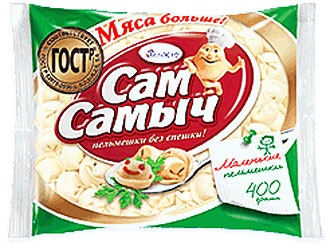
Bullfight. Good dumplings of category B. Price in terms of a kilogram of less than 200 rubles. Meat inside a lot. A good option, but on sale are rare.
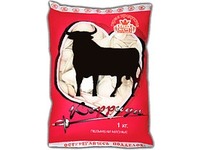
Bear's ear. At the moment - my favorite. Category B, a lot of meat. However, they are far from ideal, and homework is still noticeably better. Price - about 75-80 rubles per pack 430 grams. The package is orange, bright.
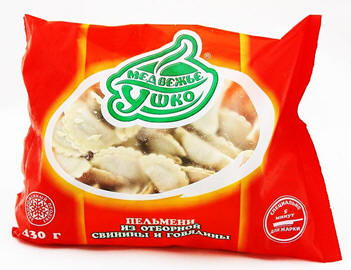
Lozhkaryov. They used to be good, but now they are spoiled. The stated category - B. Meat is, but now it is somehow tasteless. Still a good option due to the rather low price - about 160 rubles per kilogram.
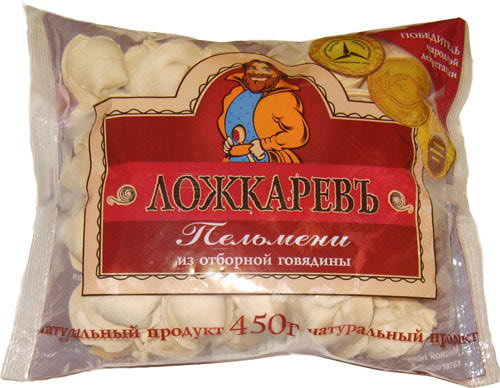
Raviollo. Overpriced, moderate taste, many additives such as flavorings, monosodium glutamate, etc. They cost about 130 rubles per pack of 450 grams; I think it’s too much for such dumplings.
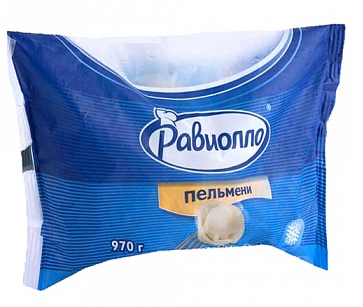
Siberian gourmet. This company produces sea dumplings of various brands. Categories - from B to G. Naturally, "B" is better. Prices - naturally, the most different, but in any case - in the framework of decency.
Caesar. Not bad, pretty, but too expensive. And the category is V.
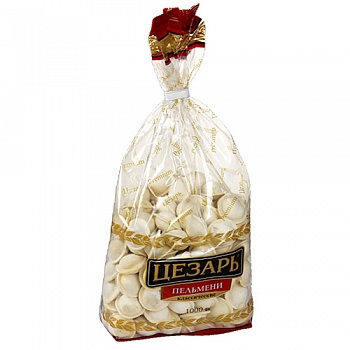
Siberian collection. The most real divorce for money. Beautiful black packaging, supposedly "premium class." However, the category - V. Price - about 400 rubles per kilogram.
Successful shopping and enjoy your meal!
Dumplings, which tested the "Public Control" in November 2010, you can safely feed the family - this was the conclusion of independent experts. Laboratory tests revealed no abnormalities in microbiological and organoleptic characteristics - taste, smell and appearance.During the examination, experts also answered the following questions:
- whether the technical conditions that are developed by the manufacturers themselves are complied with in the manufacture;
- is it always worth being guided when choosing a high price for semi-finished products?
Quality indicators dumplings
According to GOST R 52675-2006 "Semi-finished meat and meat-containing. General technical conditions", which entered into force on 01/01/2009, dumplings must have lettering on the packaging of category A, B, C, D and D.These designations mean the amount of meat (muscle tissue) in products:
- category A dumplings contain 80% or more meat;
- category B dumplings - 60-80%;
- category B dumplings - 40-60%;
- category G dumplings - 20-40%;
- dumplings category D - less than 20%.
The results of the examination of the quality of ravioli
The samples presented were evaluated by an expert commission on such indicators as “mass fraction of protein”, “mass fraction of fat in minced meat”, “mass fraction of minced meat”, composition of minced meat, appearance, smell and taste.Samples of dumplings, relevant regulatory documents
, producer LLC Talosto-Product, St. Petersburg, category G - the most lean dumplings, contain only 10.3% of fat in mince Classic dumplings "Sovereign", producer of CJSC PK Korona, Borovichi, category B - high mass fraction of protein 18.4%
Classic dumplings "Sovereign", producer of CJSC PK Korona, Borovichi, category B - high mass fraction of protein 18.4%
 , producer LLC “Ravioli”, St. Petersburg, category G - a large amount of minced meat 48%, high mass fraction of protein 18.3%
, producer LLC “Ravioli”, St. Petersburg, category G - a large amount of minced meat 48%, high mass fraction of protein 18.3%
 Classic dumplings "Caesar", producer LLC "Morozko", St. Petersburg, category B - average mass fraction of minced meat 42.7%, high fat content 28.9%, low protein content 14.7%
Classic dumplings "Caesar", producer LLC "Morozko", St. Petersburg, category B - average mass fraction of minced meat 42.7%, high fat content 28.9%, low protein content 14.7%
Samples of ravioli with deviations from regulatory documents
 Pelmeni “Monastic Traditions”, producer LLC “Traditions IPC”, St. Petersburg, category D - mass fraction of protein is underestimated: 8.9% instead of 10%
Pelmeni “Monastic Traditions”, producer LLC “Traditions IPC”, St. Petersburg, category D - mass fraction of protein is underestimated: 8.9% instead of 10%  Siberian Premium Dumplings, producer of Siberian Delicacy LLC, category G - the highest amount of minced meat is 56.5%, but the low protein content is 10.2%; does not correspond to the mass fraction of fat: 20.9% instead of 18.5%
Siberian Premium Dumplings, producer of Siberian Delicacy LLC, category G - the highest amount of minced meat is 56.5%, but the low protein content is 10.2%; does not correspond to the mass fraction of fat: 20.9% instead of 18.5%
 Pelmeni “Vkusnetskie” classic, producer “Petroholod - food technologies” LLC, St. Petersburg, category G - contain less than whole forcemeat 28%; does not correspond to the mass fraction of fat: 30.3% instead of 15%, is the fattest of all samples
Pelmeni “Vkusnetskie” classic, producer “Petroholod - food technologies” LLC, St. Petersburg, category G - contain less than whole forcemeat 28%; does not correspond to the mass fraction of fat: 30.3% instead of 15%, is the fattest of all samples
Not provided Technical conditions
 , producer of LLC Food Factory “Russky Product”, St. Petersburg, category G - low amount of protein 8.9%, high content of minced meat 48.3%
, producer of LLC Food Factory “Russky Product”, St. Petersburg, category G - low amount of protein 8.9%, high content of minced meat 48.3%
These examinations relate exclusively to specific samples submitted for examination, and not all similar products of these manufacturers.
Expert conclusions about the quality of ravioli
All samples of dumplings are not adhered, undeformed, the edges are well sealed, the stuffing does not protrude, the surface is dry.Cooked dumplings have a taste and aroma characteristic of this type of product. The stuffing is moderately juicy, with the aroma of spices, without foreign taste and smell.
The composition of the minced meat of all samples corresponds to the composition stated on the label.
Low protein levels indicate the use of cheap meat. Also, the reason may be the addition of minced soy or crackers, which is not a violation if the consumer is informed about the additives on the product label.
Some manufacturers compensate for low protein levels with high fat content by adding speck to mincemeat. The mass fraction of fat should correspond specified in regulatory documents.
According to experts, the high price does not always indicate the highest quality products. So, Caesar dumplings from Morozko LLC have the highest cost among the samples, but the mass fraction of protein in them is low - only 14.7%, and the mass fraction of fat, by contrast, is 28.9%. Also, this sample is not a record for the number of minced meat, it has an average value of 42.7%.
According to the materials of the St. Petersburg public consumer organization




